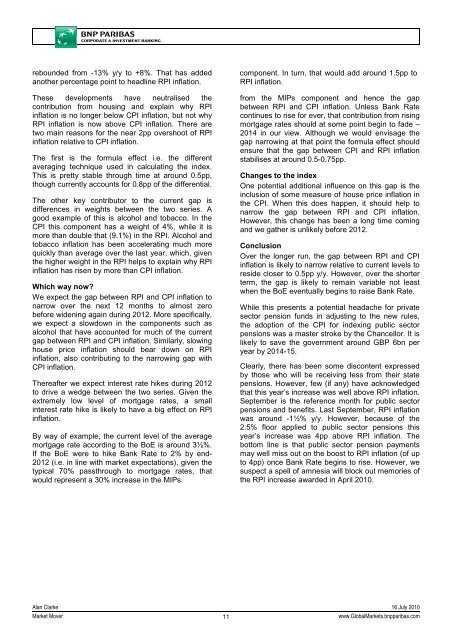Market Economics | Interest Rate Strategy - BNP PARIBAS ...
Market Economics | Interest Rate Strategy - BNP PARIBAS ...
Market Economics | Interest Rate Strategy - BNP PARIBAS ...
You also want an ePaper? Increase the reach of your titles
YUMPU automatically turns print PDFs into web optimized ePapers that Google loves.
ebounded from -13% y/y to +8%. That has added<br />
another percentage point to headline RPI inflation.<br />
These developments have neutralised the<br />
contribution from housing and explain why RPI<br />
inflation is no longer below CPI inflation, but not why<br />
RPI inflation is now above CPI inflation. There are<br />
two main reasons for the near 2pp overshoot of RPI<br />
inflation relative to CPI inflation.<br />
The first is the formula effect i.e. the different<br />
averaging technique used in calculating the index.<br />
This is pretty stable through time at around 0.5pp,<br />
though currently accounts for 0.8pp of the differential.<br />
The other key contributor to the current gap is<br />
differences in weights between the two series. A<br />
good example of this is alcohol and tobacco. In the<br />
CPI this component has a weight of 4%, while it is<br />
more than double that (9.1%) in the RPI. Alcohol and<br />
tobacco inflation has been accelerating much more<br />
quickly than average over the last year, which, given<br />
the higher weight in the RPI helps to explain why RPI<br />
inflation has risen by more than CPI inflation.<br />
Which way now?<br />
We expect the gap between RPI and CPI inflation to<br />
narrow over the next 12 months to almost zero<br />
before widening again during 2012. More specifically,<br />
we expect a slowdown in the components such as<br />
alcohol that have accounted for much of the current<br />
gap between RPI and CPI inflation. Similarly, slowing<br />
house price inflation should bear down on RPI<br />
inflation, also contributing to the narrowing gap with<br />
CPI inflation.<br />
Thereafter we expect interest rate hikes during 2012<br />
to drive a wedge between the two series. Given the<br />
extremely low level of mortgage rates, a small<br />
interest rate hike is likely to have a big effect on RPI<br />
inflation.<br />
By way of example, the current level of the average<br />
mortgage rate according to the BoE is around 3½%.<br />
If the BoE were to hike Bank <strong>Rate</strong> to 2% by end-<br />
2012 (i.e. in line with market expectations), given the<br />
typical 70% passthrough to mortgage rates, that<br />
would represent a 30% increase in the MIPs<br />
component. In turn, that would add around 1.5pp to<br />
RPI inflation.<br />
from the MIPs component and hence the gap<br />
between RPI and CPI inflation. Unless Bank <strong>Rate</strong><br />
continues to rise for ever, that contribution from rising<br />
mortgage rates should at some point begin to fade –<br />
2014 in our view. Although we would envisage the<br />
gap narrowing at that point the formula effect should<br />
ensure that the gap between CPI and RPI inflation<br />
stabilises at around 0.5-0.75pp.<br />
Changes to the index<br />
One potential additional influence on this gap is the<br />
inclusion of some measure of house price inflation in<br />
the CPI. When this does happen, it should help to<br />
narrow the gap between RPI and CPI inflation.<br />
However, this change has been a long time coming<br />
and we gather is unlikely before 2012.<br />
Conclusion<br />
Over the longer run, the gap between RPI and CPI<br />
inflation is likely to narrow relative to current levels to<br />
reside closer to 0.5pp y/y. However, over the shorter<br />
term, the gap is likely to remain variable not least<br />
when the BoE eventually begins to raise Bank <strong>Rate</strong>.<br />
While this presents a potential headache for private<br />
sector pension funds in adjusting to the new rules,<br />
the adoption of the CPI for indexing public sector<br />
pensions was a master stroke by the Chancellor. It is<br />
likely to save the government around GBP 6bn per<br />
year by 2014-15.<br />
Clearly, there has been some discontent expressed<br />
by those who will be receiving less from their state<br />
pensions. However, few (if any) have acknowledged<br />
that this year’s increase was well above RPI inflation.<br />
September is the reference month for public sector<br />
pensions and benefits. Last September, RPI inflation<br />
was around -1½% y/y. However, because of the<br />
2.5% floor applied to public sector pensions this<br />
year’s increase was 4pp above RPI inflation. The<br />
bottom line is that public sector pension payments<br />
may well miss out on the boost to RPI inflation (of up<br />
to 4pp) once Bank <strong>Rate</strong> begins to rise. However, we<br />
suspect a spell of amnesia will block out memories of<br />
the RPI increase awarded in April 2010.<br />
Alan Clarke 16 July 2010<br />
<strong>Market</strong> Mover<br />
11<br />
www.Global<strong>Market</strong>s.bnpparibas.com
















